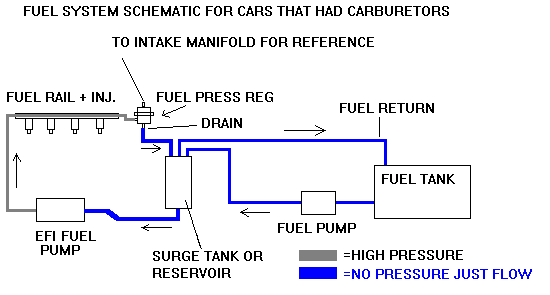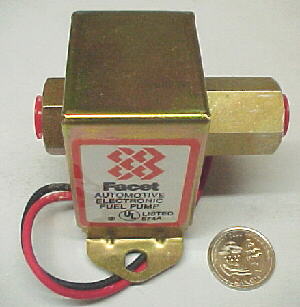FenderBumper
The "good old days" ??
I can't find any official NASCAR documents on how their fuel supply will work, but here is a diagram and explaination of the fuel supply system for cars that had carburators.
Scroll down a little and Look at the schematic. You'll see LOW pressure feeder (lift) pumps feeding LOW PRESSURE lines (BLUE) that lead to the EFI HIGH PRESSURE pump that feeds the HIGH pressure fuel lines (GREY).
So, the lift pumps NASCAR is talking about are near the tank and easily primed (if electric). They then feed high volume/low pressure (fat) fuel lines that feed the HIGH PRESSURE EFI fuel pump, which supplies 10x the fuel pressure to the injectors. Why can't they mount the high pressure pump near the tank? I'm guessing that having heavy gauge fuel lines with a bunch of fittings running the length of the car is undesirable.There are high pressure mechanical drive pumps capable of feeding the EFI, but they wouldn't be mounted back near the tank because you would need high pressure lines all the way to the injector rails. These cars are run on and off the gas constantly, so you need that HIGH pressure pump as close to the fuel rail as possible to have quicker throttle response.
------------
This is EXACTLY the system I predicted months back, with the exception of the surge tank and return lines, but rail over-pressure needs to be released somewhere. Lets hear some other guesses. Perhaps NASCAR will eventually come out with a full explaination some day.
Scroll down a little and Look at the schematic. You'll see LOW pressure feeder (lift) pumps feeding LOW PRESSURE lines (BLUE) that lead to the EFI HIGH PRESSURE pump that feeds the HIGH pressure fuel lines (GREY).
So, the lift pumps NASCAR is talking about are near the tank and easily primed (if electric). They then feed high volume/low pressure (fat) fuel lines that feed the HIGH PRESSURE EFI fuel pump, which supplies 10x the fuel pressure to the injectors. Why can't they mount the high pressure pump near the tank? I'm guessing that having heavy gauge fuel lines with a bunch of fittings running the length of the car is undesirable.There are high pressure mechanical drive pumps capable of feeding the EFI, but they wouldn't be mounted back near the tank because you would need high pressure lines all the way to the injector rails. These cars are run on and off the gas constantly, so you need that HIGH pressure pump as close to the fuel rail as possible to have quicker throttle response.
------------
This is EXACTLY the system I predicted months back, with the exception of the surge tank and return lines, but rail over-pressure needs to be released somewhere. Lets hear some other guesses. Perhaps NASCAR will eventually come out with a full explaination some day.







